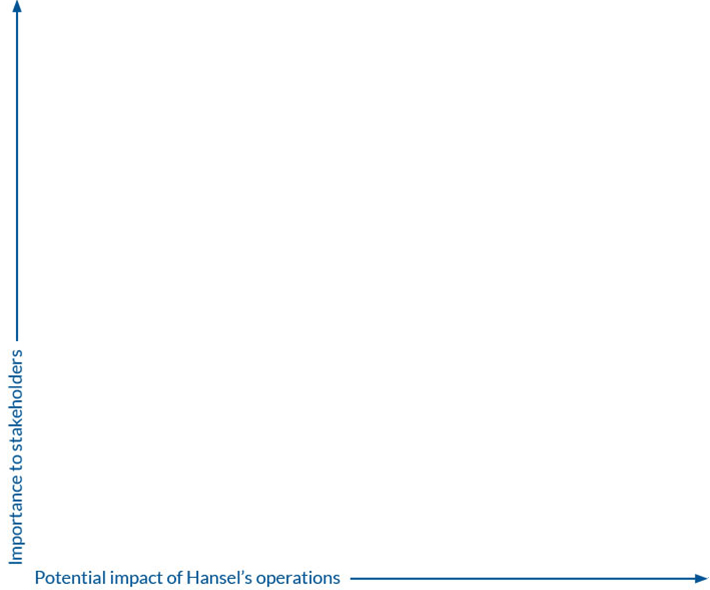Materiality assessment
Our responsibility work and communications are based on a materiality matrix that takes G4 reporting principles into account.
Core business at the heart of the materiality matrix
The responsibility themes presented in our Corporate Social Responsibility Report have been assessed in a matrix with regard to their impact on our company’s and our stakeholders’ activities. This allows Hansel to focus on reporting the key themes within corporate responsibility. Although generating savings for the State has not been specifically highlighted among our stakeholders, it is considered the most important area for our core business. A materiality assessment determines the topics that will be covered in the Corporate Social Responsibility Report.
There are several elements affecting the content of the matrix. The assessment noted the United Nations’ Sustainable Development Goals (SDG), trends in our operating environment, and Hansel’s strategy and values and the measures arising from them. Government guidelines and resolutions on Hansel have also affected the content of the matrix. Other elements that have been considered include the results of customer and supplier satisfaction surveys, analyses conducted by the responsibility team, customer and supplier feedback, and the results of our personnel work satisfaction survey.
The topics presented in the materiality matrix have been linked to recognised responsibility themes using colour codes. By clicking on the different areas of the materiality matrix, you will be able read how that responsibility theme is visible in everyday life.
The materiality index was significantly revised in autumn 2016 on the basis of a stakeholder survey. The revised matrix highlights Hansel’s responsible role in promoting responsibility in the procurement process. Major national digitalisation projects, such as Handi, also affected the materiality matrix. The materiality matrix was discussed by the responsibility team and approved by the Executive Committee.
Material indicators relating to responsibility
Based on responsibility survey and stakeholder interviews
The materiality matrix is based on an extensive responsibility survey that was conducted in 2016 and received 656 responses. This survey was based on the United Nations’ Sustainable Development Goals, and the majority of respondents represented the most important stakeholders, that is, our customers, suppliers and personnel.
Respondents assessed a number of statements on a scale of 1–5 (5 = extremely important). Respondents were given the alternative “I do not know”. Respondents were not asked to compare the statements, and there was minimal variation in the significance of the statements. The average scores for the 27 statements as a whole ranged between 4.19-4.82. The three most important areas related to social responsibility and openness:
- The companies in Hansel’s supply chain respect human rights and fundamental labour rights. This means that, for example, companies in the supply chain do not use child or forced labour, and employees work in decent conditions.
- The companies in Hansel’s supply chain pay their employees a living wage and the services they offer are priced to enable this.
- Hansel operates openly and transparently.
We also deepened our understanding of our stakeholders’ needs using six interviews. In particular, stakeholders wanted Hansel to employ more transparent operating methods and issue more communications. They also demanded the continual supervision of suppliers’ responsibility. In long supply chains in particular, it is difficult to ensure that responsibility is being implemented. However, Hansel is developing its monitoring system and supplier requirements with regard to social responsibility in particular.



























